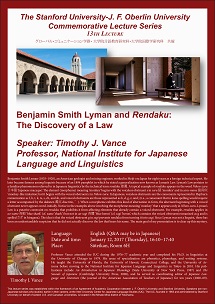Thirteenth installment of Stanford University–J. F. Oberlin University Commemorative Lecture Series to be held on Jan. 12
Benjamin Smith Lyman and Rendaku: The Discovery of a Law

Benjamin Smith Lyman (1835–1920), an American geologist and mining engineer, worked in Meiji-era Japan for eight years as a foreign technical expert. He later became famous among linguists because of an 1894 pamphlet in which he stated a generalization now known as Lyman’s Law. Lyman’s Law pertains to a familiar phenomenon referred to in Japanese linguistics by the technical term rendaku 連濁. A typical example of rendaku appears in the word Nihon-zaru 日本猿 ‘Japanese macaque.' The element (morpheme) meaning ‘monkey’ begins with the voiceless obstruent s in saru 猿 ‘monkey’ and in saru-mane 猿真似 ‘monkey-like imitation,’ but it begins with the voiced obstruent z in Nihon-zaru. In Japanese, voiceless obstruents are the consonants represented in Hepburn romanization as f, h, t, k, ts, s, ch, and sh, and voiced obstruents are those represented as b, d, g, z, and j (i.e., a consonant that in kana spelling would require a letter accompanied by the dakuten 濁点 diacritic, ゙). When a morpheme exhibits this kind of alternation in form, the alternant beginning with a voiced obstruent never appears word-initially. Notice in the examples above involving the morpheme meaning ‘monkey’ that z appears only in Nihon-zaru. Lyman’s Law is a putative constraint on rendaku that prohibits it from affecting elements that already contain a voiced obstruent. For example, rendaku applies in ao-zame 青鮫 ‘blue shark’ (cf. same ‘shark’) but not in ao-sagi 青鷺 ‘blue heron’ (cf. sagi ‘heron,' which contains the voiced obstruent romanized as g and is spelled さぎ in hiragana). The idea is that the voiced obstruent g in sagi prevents rendaku from turning it into zagi. Since Lyman was not a linguist, there has been an understandable suspicion that he did not actually discover the law that bears his name. The main goal of my presentation is to clear up this mystery.
| Speaker | Timothy J. Vance Professor, National Institute for Japanese Language and Linguistics |
|---|---|
| Date and time | January 12, 2017 (Thursday), from 16:10 to 17:40 |
| Language | English (Q&A may be in Japanese) |
| Place | Sūteikan, Room 6H Machida Campus |
Professor Vance attended the IUC during the 1976–77 academic year and completed his Ph.D. in linguistics at the University of Chicago in 1979. His areas of specialization are phonetics, phonology, and writing systems. He taught at the University of Florida, the University of Hawaii, Connecticut College, and the University of Arizona before moving to the National Institute for Japanese Language and Linguistics in Tokyo in 2010. His publications include An Introduction to Japanese Phonology (State University of New York Press, 1987) and The Sounds of Japanese (Cambridge University Press, 2008), and he served as coordinating editor of Japanese Language and Literature (the journal of the American Association of Teachers of Japanese) for ten years (2000–09).
